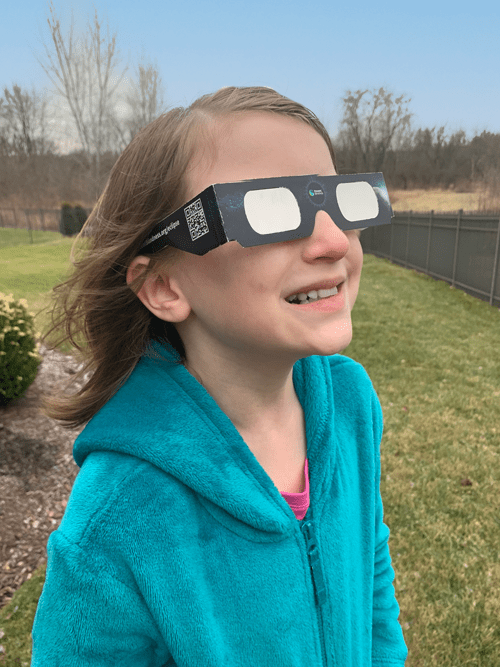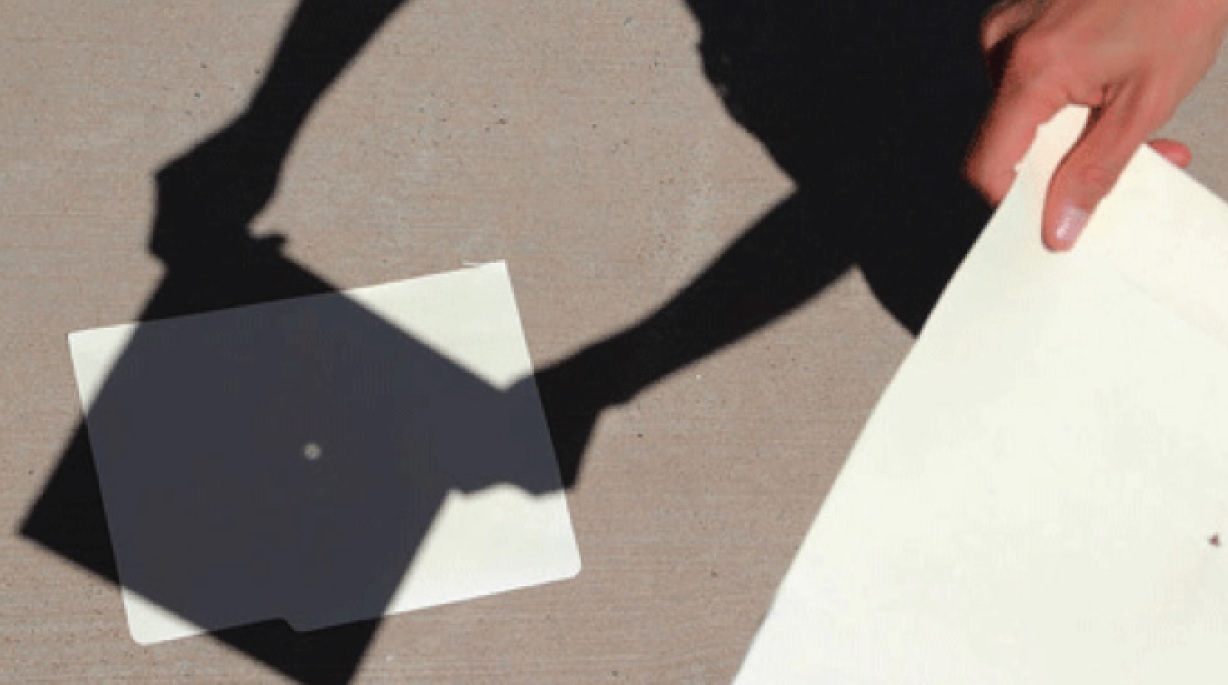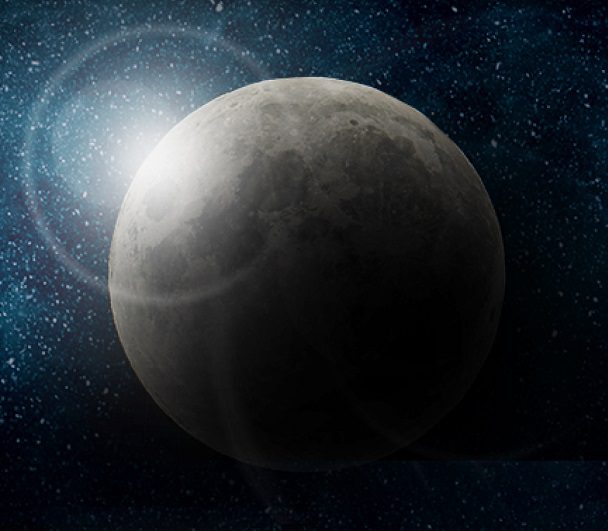Solar Eclipses Eye Safety: Protect Your Eyes from the Sun!
Never look directly at the sun during a solar eclipse (except during the very brief time the sun is in total eclipse; and even then, with caution). Looking directly at the sun can cause permanent damage to your eyes. After viewing a solar eclipse, seek treatment from an eye care professional if you or your child have any changes in vision that continue to get worse.
What You Need to Know to Protect Your Eyes During the Upcoming Solar Eclipse
Solar Eclipse + Your Eyes
What is a solar eclipse?
Solar eclipses occur when the moon moves between the sun and the earth. The moon causes the light of the sun to be blocked from reaching earth, casting a shadow on earth. A total solar eclipse is when the moon completely blocks the sun. The sun’s outer atmosphere (called the solar corona) glows around the moon when it is blocking the sun. A partial solar eclipse is when the moon only blocks part of the sun. Viewing a partial solar eclipse can expose your eye to the sun’s rays causing damage to the eye.
How can your eyes be affected by a solar eclipse?
Exposing your eyes to the sun without proper eye protection during a solar eclipse can cause “eclipse blindness” or retinal burns, also known as solar retinopathy. This exposure to the light can cause damage or even destroy cells in the retina (the back of the eye) that transmit what you see to the brain. This damage can be temporary or permanent and occurs with no pain. It can take a few hours to a few days after viewing the solar eclipse to realize the damage that has occurred.
What are the eye symptoms that can occur from looking at a solar eclipse without proper eye protection?
- Loss of central vision (solar retinopathy)
- Distorted vision
- Altered color vision
If you notice symptoms after viewing a solar eclipse, seek treatment from an eye care professional.
 Solar Eclipse Glasses
Solar Eclipse Glasses
Print and share our eclipse fact sheets!
How to safely watch a solar eclipse
Consider your eye health when watching a solar eclipse. The only time that you can safely view a solar eclipse without special equipment is during the part of a solar eclipse when the moon completely covers the sun.
It is never safe to look at a partial solar eclipse without proper safety equipment or techniques. During the very brief time the sun is in total solar eclipse it is safe to look at it, but do so with caution. Even during the total solar eclipse, the total eclipse may last only a short period of time, and if you are looking towards the sun as the moon moves away from blocking the sun, you might get a solar burn on your retina which can cause permanent damage to your eyes. Talk with your eye care professional to determine the best viewing option for you. Here a few common ways to safely watch a solar eclipse:
Solar Eclipse Glasses
Use expert-approved solar eclipse glasses to view a solar eclipse safely and without damaging your eyes.
- Make sure they meet safety requirements and are manufactured with the ISO 12312-2 standard. Look for ISO standard labeling when looking for solar eclipse glasses and purchase them from a trusted source.
- Wear your solar eclipse glasses at all times when watching an annular or partial solar eclipse.
- Wear your solar eclipse glasses at all times during a total solar eclipse, except during the very brief time the sun is in total eclipse; and even then, with caution.
Note, solar eclipse glasses can be damaged. If the lenses of your solar eclipse glasses appear torn or scratched, they are not safe to use.
Tips for Solar Eclipse Glasses
Pinhole projection

This is the safest and most inexpensive way to watch a solar eclipse. This helps you avoid looking directly at the eclipse by using a projected image. Here are simple instructions for this do-it-yourself project:
- Make a pinhole (a thumbtack should make the right sized hole) in a cardboard paper that blocks light except sunlight shining through the pinhole.
- Facing away from the sun, hold the piece of paper so that the light from the sun can shine through the pinhole without obstruction.
- Allow the sunlight shining through the pinhole to project onto a second piece of white paper that will serve as your projection screen (as shown in the image). The piece of cardboard with the pinhole should be about three feet above the piece of paper used as a screen.
- If you don’t want to punch a hole in something, a stainless steel colander or steamer (as long as it has a lot of little round holes in it) will work and make a lovely multiple pinhole projector effect on a white surface.
Keep in mind NOT to look through the pinhole at the sun.
Other Options
Welder’s glass: Number 14 welder’s glass provides effective protection and can be found at a local welder’s supply store. This glass will reduce the harmful rays that are emitted during the eclipse. Do not use if there are any scratches or damage to the glass.
Mylar filters: Aluminized mylar plastic sheets are available as eclipse vision glasses or can be cut and made into a viewing box. Do not use if there are any scratches or damage to the sheet.
Other ways: Other ways to safely watch a solar eclipse include on television or at the planetarium.
How NOT to watch a solar eclipse
Be careful about how you watch a solar eclipse.
Do NOT use your smartphone: Watching a solar eclipse on your smartphone camera can put you at risk of accidentally looking at the sun when trying to line up your camera. It could possibly also damage your smartphone camera. Don’t take the risk.
Do NOT use your camera viewfinder: Never look at a solar eclipse through the optical viewfinder of a camera. It can damage your eyes in the same way as looking directly at it.
Do NOT use unsafe filters: Unless specifically designed for viewing a solar eclipse, no filter is safe to use with any optical device (telescopes, binoculars, etc). All color film, black-and-white film that contains no silver, photographic negatives with images on them (x-rays and snapshots), smoked glass, sunglasses (single or multiple pairs), photographic neutral density filters and polarizing filters are unsafe filters to watch a solar eclipse. Also, solar filters designed for eyepieces that come with inexpensive telescopes are also unsafe. All of these items can increase your risk of damaging your eyes.
If you would like to place an order of 25 or more Prevent Blindness eclipse glasses, please contact us. A portion of all proceeds from the sale of Prevent Blindness eclipse glasses supports our sight-saving programs and services.

